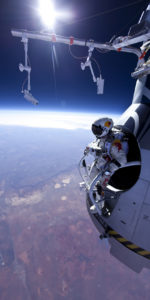
“Inspiring Kids. Inspire people to dream and achieve. Explore beyond the known and familiar. Learn as we go and help others to learn with us.” Such is the mission of forty eight Challenger Centers for Space Science Education who are touching the lives of 400,000 children a year at over 40 centers in the USA, Canada, South Korea, and England. Born out of the despair of the tragic flight of Challenger, the dreams and aspirations of those seven astronauts has risen like a phoenix from the ashes.
Just 150 miles away from the Kennedy Space Center is a typical such Challenger Center located at Kirby Middle School in Jacksonville, Florida. Led by Shereé Kearns, Senior Flight Director together with Mission Specialist Julie Aderhold Roach, and a team of 8th grade interns, the center has conducted 2,000 missions since the school was founded in 1997. Approximately 140,000 students have gone through this out of world experience. Recently a TV station, FOX 30, named the CLC as a “cool school.”

Each mission involves students conducting various experiments. A typical mission interacts with a GOES 5 weather satellite in order to evaluate data from a recent hurricane. Assignments include assembling a motherboard for the satellite, determining damage from a solar flare, determining the slope of the bottom of the ocean to determine potential flood levels for the local beaches and several others.
Kearns explained that the simulated launch occurs at the end of the second part of the mission. The SAT team discovers that the GOES 5 satellite was not damaged by the solar flare as previously thought. Instead the launch software was damaged in the clean room. SAT team members will then go to the Commander’s station to launch the satellite. The satellite is launched as mission control and the space station watch. Then the Commander signals for upload of the software from mission control to the satellite. The GOES 5 satellite receives the software and returns a signal that it is on-line and working.

Kearns and Roach are exceptionally proud of all the students who have passed through the Center . One recent participant attended one of NASA’s space adventure camps at the Kennedy Space Center, and went on to graduate from the University of Florida with an aerospace degree. The center involves students in a variety of ways as interns. Two projects that they have been working on are a Botball competition. and Team America Rocket Challenge (TARC). The Botball competition involves designing, building, programming, and documenting robots. Students use science, engineering, technology, math, and writing skills in a hands-on project that reinforces their learning. The students from Kirby Middle School designed and built a planetary expedition vehicle similar to the Mars rover currently en-route to the red planet. Under the TARC experiment the students built a 3 foot high rocket including a payload of two raw eggs. The goal was to reach an altitude of 600 feet and return to earth within 43 seconds with the eggs still intact. The Challenger interns successfully achieved their mission.

The Challenger Center for Space Science Education is headed up by Dr. Lance Bush, PhD who comes from an 18 year background with NASA starting out with the Gemini, Mercury and Apollo teams all the way though working on the design of next generation space vehicles. In a recent interview Bush stated that he was “most impressed by the scene from the Apollo 13 movie where, at the end, it showed how the crisis created an inspirational team of work and accomplishment which brought science and life together.”
Bush noted that the Challenger Center has been a pioneer in field of study of Science, Technology, Engineering and Mathematics. STEM is a key part of the U.S. Department of Education’s goal of educating the citizenry on these important issues. (for related article please read the March 4, 2012 issue on this website)
Immediate plans for the Challenger Center is to participate with NASA at the upcoming USA Science and Engineering Festival to be held in Washington D.C. on April 28-29. At the festival Challenger and NASA will demonstrate some of the experiments and projects similar to those done on a local level. On the longer term horizon Dr. Bush stated that he would like to see even more than the 400,000 students a year go through their programs. He plans on bringing the centers to the next level with “new and improved missions and technology.” His goal is to create a “scientifically literate population.” Bush concluded by observing that if the Challenger Learning Centers can help today’s youth become better citizens and better stewards that would be “fabulous.”
For more information about the Challenger Centers click here: www.challenger.org
Missions » Apollo » Apollo 1 » Missions » Apollo »




I would like to inquire about a class field trip to the challenger center for my fifth grade class. Cost of admission and other details.
Thanks
Mrs. Sharp
Dear Mrs. Sharp
Thank you for your inquiry. Could you please let me know where you are located, and we will put you in touch with the nearest Challenger Learning Center.
Graham Martin